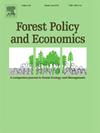Private forest owner preferences for action- and result-based biodiversity restoration contracts – A discrete choice experiment in Denmark and Finland
IF 3.8
2区 农林科学
Q1 ECONOMICS
引用次数: 0
Abstract
Payment for ecosystem services schemes aimed at private forest owners have recently garnered renewed interest as a policy tool to promote forest restoration efforts in the EU. Although schemes that pay for biodiversity results rather than management actions have not yet been applied in the European forest sector, the EU's new State aid regulations now explicitly allow for their implementation, as evidence from the agricultural sector suggests that they are potentially more cost-effective than their action-based counterparts. We conduct a discrete choice experiment to estimate Danish and Finnish forest owners' compensation requirements for engaging in action- and result-based biodiversity schemes with contract targets based on empirically established relationships between forest structural attributes and species richness levels. We find that, on average and depending on the schemes' targets, Danish forest owners need 29–56% more compensation to enroll in result-based contracts than in action-based ones, while Finnish forest owners require a markup of 101–135%. Our results demonstrate that average compensation requirements for voluntary biodiversity schemes can vary substantially across countries and contract designs. In terms of scheme design, forest owners generally favor payments in annual instalments to lump sum payments at the start or end of the contract term, and for payments to be tied to continuous increases in outcome indicators rather than to particular thresholds. Danish owners prefer to monitor contract outcomes with support of a consultant, on average. Finnish owners have a preference for self-monitoring under action-based contracts, but highly disprefer being involved in monitoring efforts under result-based contracts.
私人森林所有者对基于行动和结果的生物多样性恢复合同的偏好——丹麦和芬兰的离散选择实验
最近,针对私人森林所有者的生态系统服务计划的付款作为一种促进欧盟森林恢复工作的政策工具重新引起了人们的兴趣。虽然欧洲森林部门尚未实施为生物多样性成果而非管理行动付费的计划,但欧盟新的国家援助条例现在明确允许实施这些计划,因为来自农业部门的证据表明,这些计划可能比基于行动的计划更具成本效益。基于经验建立的森林结构属性和物种丰富度之间的关系,我们进行了一个离散选择实验,以估计丹麦和芬兰森林所有者参与基于行动和结果的生物多样性计划的补偿要求。我们发现,根据计划目标的不同,平均而言,丹麦森林所有者签订基于结果的合同比基于行动的合同需要多29-56%的补偿,而芬兰森林所有者需要101-135%的加价。我们的研究结果表明,自愿生物多样性计划的平均补偿要求在不同的国家和合同设计之间存在很大差异。在方案设计方面,森林所有者一般倾向于按年分期付款,而不是在合同期限开始或结束时一次性付款,并且付款与结果指标的持续增长挂钩,而不是与特定的阈值挂钩。平均而言,丹麦业主更愿意在顾问的支持下监督合同结果。芬兰业主倾向于在基于行动的合同下进行自我监督,但非常不喜欢参与基于结果的合同下的监督工作。
本文章由计算机程序翻译,如有差异,请以英文原文为准。
求助全文
约1分钟内获得全文
求助全文
来源期刊

Forest Policy and Economics
农林科学-林学
CiteScore
9.00
自引率
7.50%
发文量
148
审稿时长
21.9 weeks
期刊介绍:
Forest Policy and Economics is a leading scientific journal that publishes peer-reviewed policy and economics research relating to forests, forested landscapes, forest-related industries, and other forest-relevant land uses. It also welcomes contributions from other social sciences and humanities perspectives that make clear theoretical, conceptual and methodological contributions to the existing state-of-the-art literature on forests and related land use systems. These disciplines include, but are not limited to, sociology, anthropology, human geography, history, jurisprudence, planning, development studies, and psychology research on forests. Forest Policy and Economics is global in scope and publishes multiple article types of high scientific standard. Acceptance for publication is subject to a double-blind peer-review process.
 求助内容:
求助内容: 应助结果提醒方式:
应助结果提醒方式:


